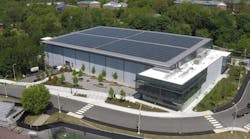Honeywell and the U.S. Air Force recently announced a $243 million facility-modernization project at Tinker Air Force Base in Oklahoma City, Okla., that is expected to reduce energy consumption by 23 percent and save the base $20.5 million in energy and operational costs a year. It is the largest energy-savings performance contract (ESPC) ever awarded by the Air Force.
A joint effort among Tinker, Honeywell, the Defense Logistics Agency Energy, Headquarters Air Force Materiel Command, and the Air Force Civil Engineer Center, the project will focus on improvements to production facilities at the Oklahoma City - Air Logistics Complex (OC-ALC), which employs more than 9,000 people and is one of three air-logistics complexes operated within the Air Force Sustainment Center, Air Force Materiel Command. The work will be funded through a 21-year ESPC awarded to Honeywell by the Defense Logistics Agency Energy. The ESPC will enable the Air Force to fund upgrades using annual energy and operational savings guaranteed by Honeywell, eliminating the need for any upfront capital investment by the Air Force.
The improvements are expected to save the Air Logistics Complex more than $626 million in energy and operational costs over the life of the project. In the first year alone, the base is expected to save more than $6.7 million in energy expenses and $13.4 million in operational costs.
“We are honored to be home to the largest energy retrofit project in Air Force history,” Brig. Gen. Mark K. Johnson, OC-ALC commander, said. “This is a big milestone for Tinker Air Force Base and the Air Force in our journey to achieving operational efficiency, and we thank both the Secretary of the Air Force Leadership and Honeywell for making this achievement possible. In addition to increasing productivity, the improvements will also make us more competitive in the private sector for aircraft-maintenance work through decreasing our energy costs.”
The project focuses on upgrading infrastructure and industrial processes at the base’s production facilities to make the buildings more energy and operationally efficient. The work includes:
- Modernizing manufacturing lines to eliminate wasted ventilation and increase worker safety.
- Updating wastewater treatment systems to provide equipment control and alarm monitoring.
- Installing two new 2,000-ton chillers to increase the reliability of the cooling system.
- Upgrading paint booths to reduce energy used by the painting process.
- Decentralizing the steam heating plant with a distributed heat system to lower energy use.
- Installing more efficient LED lighting with wireless controls.
- Installing smart meters to more closely monitor and track building energy consumption.
Additionally, Honeywell will integrate new buildings on the base into Tinker Air Force Base’s existing Honeywell Enterprise Buildings Integrator building-management system, which manages and controls heating, cooling, and metering equipment. After the upgrades are completed, Honeywell will provide ongoing maintenance and service to building systems.
“Beyond saving energy and lowering operating costs, this is an opportunity to modernize Tinker Air Force Base’s industrial operations,” John Rajchert, president of Honeywell Building Solutions, said. “Honeywell is pleased to partner with the Air Force in this endeavor and help them achieve operational excellence through software, energy, and industrial-process upgrades. This project is not only a big win for Honeywell, but also for the U.S. government, military, and taxpayers as we drive sustainability in our country by improving the infrastructure to boost operational and energy efficiency.”
The project builds on previous Honeywell work at Tinker Air Force Base. To date, the base has reduced overall energy use by approximately 37 percent and saved approximately $12 million in annual energy and operating costs.










